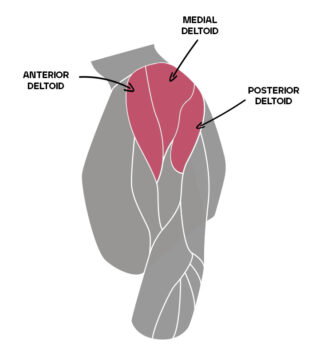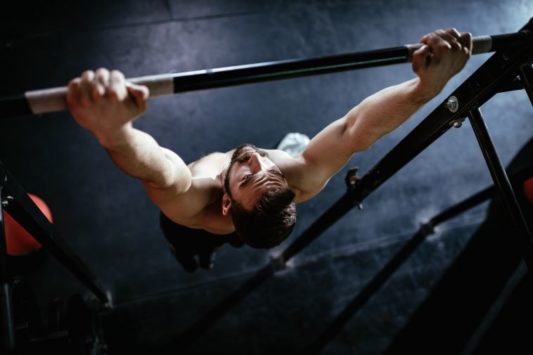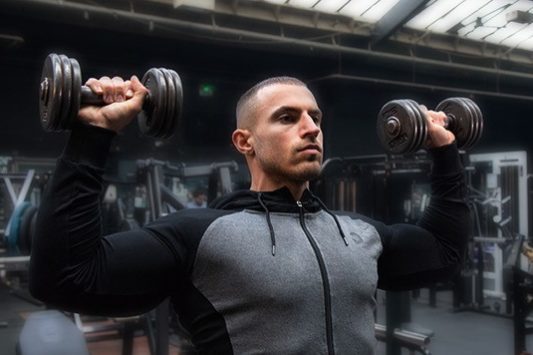Looking for ways to improve your push and pull workout? In this quick guide, we’ll go through the steps you can follow to work on your push-pull split. Below you’ll find an easy-to-follow list of shoulder push and pull exercises you can incorporate into your workout routine starting off with the basics.
The deltoids are made up of three heads: the anterior (front) lateral (middle) and posterior (rear). This means that in order to effectively target the whole of the deltoids, movements must be performed which require each head to contract and relax.
Splitting your training into a Push/Pull/Legs routine has become popular over recent years, as it’s possible to train each muscle group twice per week when training 6 days per week and taking one off-day, and also allows for 48 hours rest between performing the same exercises to promote recovery.
What is Push/Pull/Legs?
This routine splits the upper body by posterior and anterior chain. This is to separate the movements that require pushing/pressing movements (push day workout) and pulling movements (pull day workout). The third day is solely for lower body movements.
- Push Day – Chest Presses (Horizontal), Chest Flyes, Shoulder Presses (Vertical) and Triceps Extension/Press Movements.
- Pull Day – Low/Medial Rows (Horizontal), High-Rows (Vertical), Shoulder Accessories (Lateral/Front Raises & Transverse Abduction for Rear Deltoids), as well as Bicep Curls.
Are shoulders push or pull?
Shoulder movements tend to be performed on push day. This is because during pressing (or pushing) movements, the shoulder is either involved as a secondary muscle (such as in bench press) or a primary muscle group (overhead press). These work the anterior and medial head of the deltoids.
However, many pull movements use the shoulder – specifically the posterior head of the deltoid. The only pull movement can be called a ‘shoulder exercise’ is the upright row, which involves all three heads of the deltoid. But generally, shoulders are mainly performed on pressing days.

Shoulder push exercises
To target the anterior (front) deltoids effectively it’s important to perform vertical/incline pressing movements.
Exercises you should definitely consider within your push day include:
- Military Press
- Incline Dumbbell Press
- Incline Bench Press
- Arnold Press
- Incline Chest Press (Plate Loaded or Stack & Pin)
Shoulder pull exercises
Shoulder accessory movements are important for targeting the lateral and rear delts.
Exercises you should definitely consider within your pull day include:
- Lateral Raises (Dumbbell)
- Front Raises (Dumbbell)
- Rear Deltoid Fly (Stack & Pin Machine or Dumbbell)
- Face Pulls (Cable with Rope)
- Upright Row
Is it OK to do shoulders on pull day?
As mentioned before, shoulders are mainly done on push day. However, it is fine to do them on pull day if you’d like. There are many pull movements, such as rows, pull-ups and rear-delt flyes that exercise the shoulder. Upright rows primarily target your side delts and trap muscles.
Are lateral raises push or pull?
When we hear the term “pushing exercises” we basically can include all exercises that target the front of the body, with the exception of the triceps. This includes the front part of the shoulder (anterior deltoid) that are worked during lateral raises. But lateral raises are named so because they mainly work the lateral (side) head of the shoulders. But since the anterior deltoid is a secondary muscle involved in other compound movements on push day, it makes sense to do lateral raises on push day too.
Rotating your shoulder push and pull exercises
As there are five different types of shoulder exercise for both Push and Pull day, it may be worth rotating the exercises between your sessions. The beauty of rotating Push/Pull/Legs twice per week is that you are able to target each muscle group twice every week and therefore you have the opportunity to utilise a variety of exercises.

Full Push Day One (Example)
- Decline Barbell Bench Press
- Incline Dumbbell Press
- Chest Press (Plate-Loaded)
- Arnold Press
- Triceps Extension (EZ Bar – Cable)
- Skull Crushers
4 Sets of Each (Total Sets 24)
Full Pull Day One (Example)
- Lat Pull Down
- Dumbbell Row
- Uni-Lateral Vertical Plate Loaded Row
- Uni-Lateral Horizontal Plate Loaded Row
- Lateral Raise (Dumbbells)
- Rear Deltoid Fly (Stack & Pin Machine)
- Biceps Curl (EZ Bar – Cable)
- Biceps Curl (Alternate Dumbbells)
3 Sets of Each (Total Sets 24)
Each of the heads of the deltoids will be targeted by using the above two training plans for Push and Pull day. However, in order to keep the volume up and make use of the rest of the exercises mentioned previously, we have created a second Push and Pull day which can be used in conjunction with the above.
Full Push Day Two (Example)
- Military Press
- Flat Bench Press
- Shoulder Press (Plate Loaded)
- Chest Fly (Cables)
- Triceps Dips
- Triceps Overhead Extension (Barbell)
4 Sets of Each (Total Sets 24)
Full Pull Day Two (Example)
- Rack-Pull Deadlifts
- Lat Pull Down (Close Grip)
- T-Bar Row
- Pullovers (Cable – EZ Bar)
- Front Raises (Dumbbell)
- Face Pulls (Cable – Rope)
- Upright Row
- Biceps Curl (Rope – Cable) SUPER SET W/ Biceps Curl (Barbell)
3 Sets of Each (Total Sets 24)
Whole Session Time
Each of the above training routines consists of 24 sets. Every set should take 45 seconds to 1 minute to perform, and a rest period of the same time should be taken between each set and exercise.
This brings the full session time to 48 minutes excluding a warm-up and cool-down. We would recommend a five-minute row prior to each session as a warm-up accompanied by some dynamic warm-up movements, and a five-minute cycle as a cool-down followed by static stretches. Performing warm-ups increases muscle temperature and blood flow, which contributes to improved exercise performance and reduced risk of injuries to muscles and tendons [1].
Take-Home Message
Rather than splitting your training days into individual muscle groups (e.g. shoulders, arms, chest, legs, back), this routine allows you to target each muscle group more frequently. Be sure to split your shoulder movements between Push and Pull day, as each head can be isolated using different movements.
Related articles
Hungry to learn more? We believe that every person, with support, has the right to transform their lives through fitness. That’s why we’ve put together hundreds of articles with expert advice, all to help you on your fitness journey. From structuring a pull day to more shoulder exercises, check out our relevant articles below:
Pyramid sets Running in the cold
Leg day workout Push day workout
HIIT heart rate Fitness training methods
Full body split Building muscle mass
Best macro split How to lean bulk
Pull day workout
Bench press muscles worked












